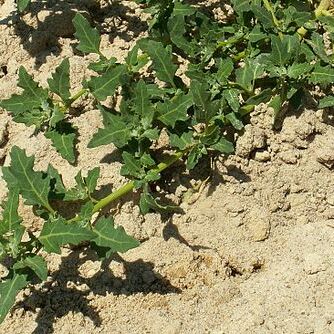Stems erect to prostrate, branched from base, 0.5-2.5(-4) dm, farinose. Leaves nonaromatic; petiole to 1 cm; blade lanceolate to oblong or ovate, 0.5-4 × 0.3-1.5 cm, base cuneate, margins undulate-dentate, teeth obtuse or acute, apex obtuse or acute, densely farinose, glaucous abaxially. Inflorescences glomerules in terminal or lateral spikes, 5-10 cm; glomerules subglobose, 1.8-2.5 mm diam.; bracts leaflike in inflorescence, elliptic, 0.2-1 × 0.1-0.5 cm, or absent at least in terminal 1/2 of inflorescence. Flowers: perianth segments 3-4; lobes obovate to oblong, 0.5-0.7 × 0.4-0.5 mm, apex obtuse, rounded, not keeled, covering fruit at maturity; stamen 1; stigmas 2. Utricles ovoid; pericarp nonadherent, smooth. Seeds mostly horizontal, some vertical, margins rounded; vertical seeds ovoid to round, 0.6-1.1 mm diam.; horizontal seeds round, 0.6-1.1 mm diam.; seed coat reddish brown, rugose-punctate. 2n = 18.
Prostrate or semi-prostrate annual herb, with young parts farinose, often reddish or purplish, sometimes green. Stems to 20-(30) cm long, slender, branched. Petioles 5-15-(18) mm long. Lamina 3-20-(55) × 2-18-(60) mm (including basal lobes), rhombic-ovate, narrow-elliptic, ± succulent, becoming efarinose and green or reddish above, nearly always glaucous-white-farinose beneath, entire, with few dentate teeth or sometimes basally lobed on each side; base cuneate. Glomerules few-flowered, axillary and terminal, sometimes spike-like, otherwise leafy to apex. Perianth segments 3-4-(5), broadly ovate, generally reddish except for margin, green or brownish at fruiting, membranous, not very accrescent, scarcely investing fr. Seed mostly horizontal, (0.8)-1-1.3-(1.6) mm diam., circular, compressed; margin obtuse; pericarp easily removed; testa glossy black, finely striated.
Prostrate to erect annual to 0.5 m high, branching from base. Leaves slightly fleshy, elliptic to deltoid, entire or sinuately lobed, obtuse; lamina 1–3 cm long, passing into a petiole c. half as long, glabrous above, densely mealy below. Infloresence of compact glomerules arranged in paniculate cymes. Flowers glabrous; terminal flowers bisexual, the tepals 3 or 4, rarely 5, free, the stamens 1–4, rarely 5, seed horizontal; lateral flowers female or bisexual, the tepals 3, rarely 4, stamen 0 or 1, seed erect. Pericarp thin, free or almost so, somewhat green. Seed discoid with rounded margin, c. 1 mm diam.; testa reticulate, smooth or finely pitted, reddish brown to black; embryo circular.
Annual, usually branched from the base, prostrate to erect, 1–4 dm; lvs lanceolate to oblong or ovate, 1–4 cm, cuneate at base, entire or merely undulate, or with 2–4 low teeth per side, densely white-mealy beneath, especially when young; fls in small glomerules aggregated into usually interrupted spiciform clusters equaling or shorter than the lvs, or also in a short terminal panicle; sep mostly 3(4); seeds dark brown, shining, lenticular, 0.6–1 mm wide, loose in the pericarp, those of the lateral fls of the cymules erect, that of the terminal fl in the cymule horizontal; 2n=28. Native of Europe, occasionally found as a weed in our range, especially northward. (C. salinum)
An annual herb. It can be 20-40 cm tall but branches can be 80 cm long. The leaves are fleshy and 5-40 mm long. There are teeth along the edge. The upper surface is smooth and dark green. The lower surface is white with dense hairs. The flowers are small and pale green. They form dense clusters in the axils of leaves.

